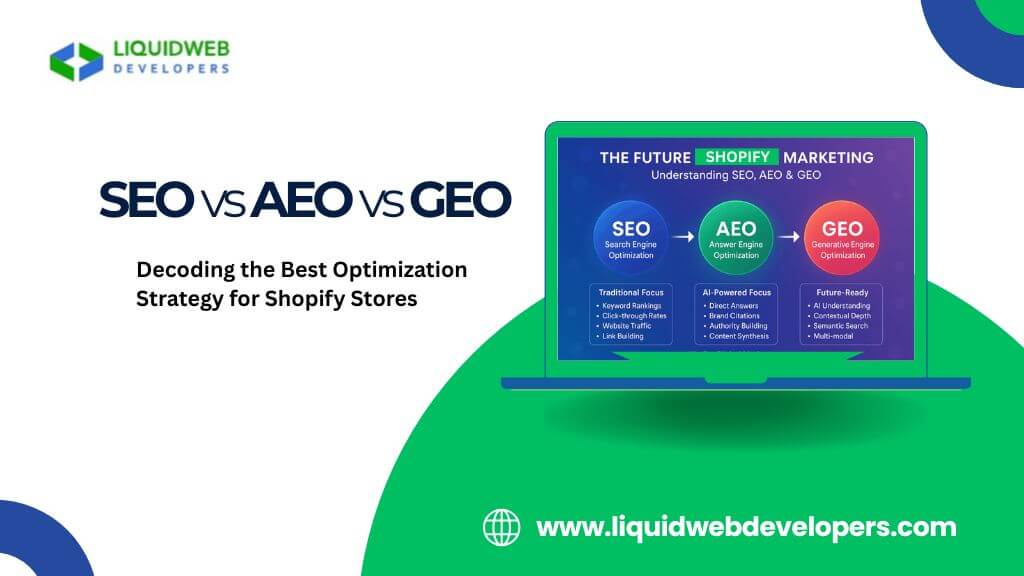SEO vs AEO vs GEO: Decoding the Best Optimization Strategy for Shopify Stores

Introduction: The Shopify Store Owner’s Optimization Dilemma
Traffic in 2025 is fragmented. Shoppers still use Google, but they also ask AI assistants questions and expect localized pricing, language, and delivery promises. That’s why your optimization plan can’t be one-dimensional. You need the right mix of SEO, AEO, and GEO to match how people discover and buy. Click here for more info on SEO vs AEO vs GEO.
This guide breaks down what each strategy does, where it wins, where it falls short, and how to stack them for growth, so you can improve how to get more Shopify store traffic without wasting months on tactics that don’t fit your goals.
What is SEO for Shopify—and Why It’s Still King of Traffic
SEO for Shopify is about earning visibility in traditional search engines. Done right, it compounds, bringing steady, high-intent visitors to your product and collection pages.
Core pillars for Shopify:
- Architecture & intent mapping: Group products into clean collections, limit faceted duplicates, and keep crawl paths shallow. This is foundational search engine optimization for Shopify and boosts Shopify’s search visibility.
- On-page product hygiene: Write benefit-first titles, scannable bullet points, real specs, and comparison blocks. This is practical Shopify content optimization.
- Structured data: Add Product, Offer, Review, and Breadcrumb JSON-LD to help search engines understand your cataloge—key Shopify store ranking factors.
- Speed & UX: Optimize images, use app discipline, and monitor LCP/CLS. Page speed remains central to optimizing for Google search.
- Editorial moat: Create buying guides, comparisons, and how-tos that answer pre-purchase questions—your durable moat for rankings.
Quick win checklist (pin it):
- Descriptive product titles (brand + model + primary use)
- Unique descriptions per variant
- Internal links from guides → collections → products
- Clean URLs and canonical tags
- Image alt text and media metadata
- Review schema and Q&A blocks
Use this as your living eCommerce SEO checklist of Shopify SEO tips.
What is AEO—The Newcomer Changing the Game?
AEO (Answer Engine Optimization) prepares your content to be selected by AI assistants and voice devices. Instead of long, meandering content, AEO favors direct, concise answers to specific questions.
How to optimize for AEO:
- Question clustering: Build sections that answer “what/why/how/cost/near me/compare” in ≤50 words each. This aligns with answer engine optimization and voice search optimization.
- FAQ schema where it matters: Add FAQs on category and PDPs to surface instant answers in AI search ranking contexts.
- Conversational headings: Use the exact phrasing users ask (e.g., “How do I size this?”) for stronger SEO vs voice search optimization performance.
- TL;DR blocks: Put a one-paragraph summary at the top of guides for AI extractability.
AEO doesn’t replace SEO; it unlocks new discovery surfaces. Think “featured answers” rather than “10,000-word guides.” This is your AEO vs SEO comparison in one line:SEO builds breadth; AEO crafts the best single answer.
What is GEO—Your Ticket to Local & Global Markets?
GEO (Geographic Optimization) matches your store experience to where the shopper is—city, state, country, or region.
Local & international GEO moves:
- Shopify Markets setup: Enable multi-currency, local domains/subfolders, and correct hreflang—core Shopify localization strategy and international SEO for Shopify.
- Pricing & messaging by region: Use Shopify geolocation apps and Shopify geo-based pricing to show accurate currency, duties, and delivery windows—clear GEO targeting benefits.
- Localized content: Country-specific size guides, shipping pages, and seasonal collections—strong location-based SEO strategy.
- Geo campaigns: Run geo-targeted marketing Shopify ads and landing pages for top cities/regions to lift conversion rates.
If you sell in multiple countries, GEO is not optional. It’s how you turn visits into orders with relevance. That’s search optimization for a Shopify store strategy for real buyers, not just bots.
The Face-Off: SEO vs. AEO vs. GEO
Different inputs, different outputs—use them together.
Strategy Where It Wins: Time to Impact Key Risk SEOBroad: non-brand discovery, sustained growth Medium to long competitive niches slow wins AEOVoice & AI answers, zero-click visibility Fast to medium Overly terse content can underserve buyers.GEO Local & international conversions Fast once configured Misconfigured hreflang/currency hurts trust.
Don’t pick “GEO targeting vs SEO Shopify” or “AEO or SEO.” Stack them. SEO brings reach, AEO captures answers, and GEO converts with relevance.
How to Pick the Right Strategy for Your Shopify Store
Use this quick decision flow:
- New or low-visibility store: Start with how to improve my Shopify search rankings—technical audit, intent-mapped collections, and a 4–6 page content spine. That’s your step-by-step SEO guide for Shopify stores.
- High impressions, low clicks: Add AEO. Build FAQs on key pages, write concise answers, and implement FAQ schema—smart SEO optimization tips for Shopify.
- Traffic but weak international or local conversion: Prioritize how to use GEO targeting in Shopify with Markets, localized pages, and shipping promises.
12-Week layered plan (practical):
- Weeks 1–2: Fix crawl issues, speed, and schema; finalize site architecture.
- Weeks 3–4: Publish 6 intent-driven collection pages; add internal links.
- Weeks 5–6: Add AEO: FAQs to top 10 PDPs + TL;DR on 3 guides (aim for SEO vs AEO for voice search results wins).
- Weeks 7–8: Launch Shopify Markets and geographic optimization basics (domains/subfolders, hreflang).
- Weeks 9–10: Create 3 country-specific landing pages (shipping, returns, sizing).
- Weeks 11–12: Spin up geo-targeted marketing Shopify ads and measure lift.
KPI guardrails:
- Non-brand clicks (+20–40% in 90 days) from optimizing for Google search
- Product page CTR from answer panels (AEO)
- Intl sessions share and CVR (GEO)
- Blended ROAS across regions
Conclusion: Your Next Step to Shopify Growth
The best optimization strategy isn’t a coin toss between SEO, AEO, and GEO—it’s the right order and the right blend. Lead with SEO to build durable visibility, layer AEO to capture AI and voice demand, and deploy GEO to convert visitors with localized trust signals. That’s how the optimization strategy that brings more sales becomes a measurable, repeatable system.
FAQ
Why are Shopify stores struggling to get consistent traffic in 2025?
Competition, richer SERPs, and AI-driven answers siphon clicks. You need resilient search engine optimization for Shopify Plus answer engine optimization to stay visible, then GEO to convert.
Which SEO strategies work best for increasing Shopify store visibility?
Intent-mapped collections, internal linking, structured data, and fast PDPs. Add guides that compare products and solve real problems—practical Shopify SEO tips.
How can Shopify merchants optimize product pages for voice search results?
Add short, direct Q&As, conversational headings, and FAQ schema. This is hands-on voice search optimization and answer engine optimization for online stores.
What are the best GEO optimization tools available for Shopify?
Shopify Markets, Shopify geolocation apps, and translation/localization tools. Use them with a clear Shopify localization strategy and multi-currency SEO for Shopify.
SEO vs AEO vs GEO—which strategy drives more conversions for Shopify?
Stacked strategies win. SEO fills the funnel, AEO captures question traffic, and GEO personalizes pricing and shipping—together they lift CVR.
How do I decide between SEO, AEO, and GEO for my Shopify business goals?
Start with your constraint: low visibility (SEO), weak answer presence (AEO), or poor regional conversion (GEO). Then layer all three—the scalable play for Shopify optimization for international sales and domestic growth.
